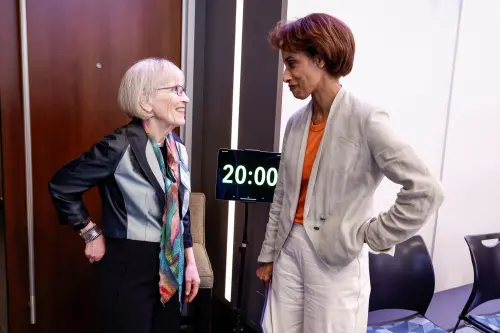The first line of Claudia Goldin’s Nobel Lecture notes, “Women are now at the center of the world’s economies.” Indeed, labor force participation rates for prime-age women in the U.S. have grown significantly over time, and, earlier this year, prime-age women exceeded their highest labor force participation rate ever: Since January 2024, about 78 percent of women between the ages of 25 and 54 have participated in the labor force (figure 1). These prime-age women make up 30 percent of the civilian labor force, relative to 34 percent for prime-age men. And, over the past five years, prime-age women have driven much of the increase in the overall labor force participation rate.
While prime-age women all together reached their highest labor force participation in recent months, the participation rates vary greatly for prime-age women in different demographic groups. Figure 2 shows the labor force participation rate for prime-age women over the last decade by various breakdowns: race and ethnicity (A), educational attainment (B), marital status (C), nativity (D), and disability status (E). The gray line in each panel shows the overall labor force participation rate for prime-age women over this period. Use the dropdown menu above the figure to navigate between the panels.
All-time peak labor force participation rates have occurred in the past year for prime-age women overall as well as for most of the demographic groups shown in the data interactive. As of May 2024, the labor force participation rate for each demographic group of prime-age women shown in figures 2 and 3 is higher than it was in May 2019. Even for groups that have not reached their peak in this recent period, labor force participation rates have gotten very close in recent months or continue to be on the upswing. Labor force participation growth has thus been quite widespread among groups of prime-age women. We note that increases in propensity to participate have been quite large among foreign-born prime-age women, prime-age mothers of young children (especially those with at least a bachelor’s degree), and prime-age women with disabilities.
There is emerging evidence, however, that the remarkable post-pandemic increase in labor force participation among prime-age mothers with young children has stalled out in the past several months. Figure 3 shows the labor force participation rate over the last 10 years for prime-age women by the age of their youngest child in the household. Among mothers with children under five, the post-2020 increase in participation peaked in September 2023 and has fallen somewhat since then.
This plateau in participation among prime-age mothers with young children in recent months is most evident when we decompose the net change in the total labor force participation rate over various periods. In figure 4, we show the contribution of changing labor force participation rates within different demographic groups to the total change in the labor force participation rate in recent years, holding the size of each group constant. Consistent with the approach in Bauer et al. 2023, we pool together two months of data for each period (April and May) because these months marked the nadir of participation in 2020. We break the net change from April–May 2019 to April–May 2024 into three periods: the labor market collapse (April–May 2019 to April–May 2020), the first three years of recovery (April–May 2020 to April–May 2023), and the most recent year (April–May 2023 to April–May 2024). Figure 4’s legend goes in order of the top series, from left to right. Hover or click to highlight a group.
Over the five years between April–May 2019 and April–May 2024, there was a reduction in the overall labor force participation rate of 0.48 percentage points. The increase in the propensity to participate (0.08 percentage points) did not offset the decrease related to changes in the composition of the population (0.56 percentage points). Prime-age women, however, have contributed the most to the growth in aggregate participation: 0.57 percentage points. As of last year, within this group, those with young children (youngest child under 5) had experienced the largest growth in participation relative to April–May 2019, but this is no longer the case. In the past year, participation growth among prime-age women is again contributing by far the most to net gains in the aggregate labor force participation rate (one-tenth of a percentage point), but mothers with young children are less likely to be participating now relative to April–May 2023.
While some have argued that participation growth may be peaking, so far this seems to be more true among prime-age men than women. Given the contours of women’s work-related challenges during the pandemic—a service-sector-led recession, caregiving challenges related to school closures and childcare funding, and concerns about scarring—it is notable that prime-age women have powered, and continue to power, the recent labor force recovery.
-
Acknowledgements and disclosures
The authors are grateful to Brad Hershbein and Wendy Edelberg for their helpful comments. The authors also thank Victoria Yan for her research support.
The Brookings Institution is financed through the support of a diverse array of foundations, corporations, governments, individuals, as well as an endowment. A list of donors can be found in our annual reports published online here. The findings, interpretations, and conclusions in this report are solely those of its author(s) and are not influenced by any donation.






